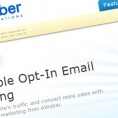Innovation is one of today’s hottest business topics, but many organizations often struggle to build successful strategies for making the concept work. One of the best descriptions of the challenges that enterprises encounter comes from Disrupt Yourself author Whitney Johnson, as she takes a closer look at what she calls “the S curve of innovation.” To summarize, often as a business, we begin working extremely hard to make progress in a new field. Then we come to understand the field enough to accomplish goals without strain. But over time, we get so comfortable with success that our creativity and willingness to take risks starts to atrophy, and when we’re not learning or being challenged anymore, our willingness to purposefully seek out ways to raise the bar often goes by the wayside. To create a culture where innovation and creativity consistently thrive, the key to avoiding these traps, she says, is to remain passionate and proactive, taking the necessary risks to expand your horizons and capabilities. Doing so can effectively increase your organization’s ability to succeed – and helps you create new S curves that force you and your team to constantly be challenged and actively on the hunt for new ideas and solutions to overcome these challenges.
To win with innovation, and create a culture where innovation thrives, begin by defining a vision and purpose for your organization that champions new ways of thinking and doing business. For example, Allstate Insurance, home to 70,000 employees, lives by a simple, yet powerful mission statement: “Deliver substantially more value than the competition by reinventing protection and retirement to improve customers’ lives.” Its operating principles are equally succinct, yet telling:
- Put the customer at the center of all our actions.
- Use consumer insights, data, technology, and people to create disruptive innovation to better serve customers and generate growth.
- Execute well-considered decisions with precision and speed.
- Focus relentlessly on those few things that provide the greatest impact.
- Be a learning organization that leverages successes, learns from failures, and continuously improves.
- Provide employees and [partners] fulfilling opportunities, personal growth, and performance-based rewards.
- Take an enterprise view of people and processes, and work as a single team to advance Allstate rather than our individual interests.
An easily understood and hugely transformative approach to thinking, Allstate’s model offers a practical, actionable playbook for driving strategic innovation inside organizations of every size. Corning Chief Technologist Dr. Waguih Ishak describes the need to provide models such as these as offering “roots and wings” that ground working professionals in and organization’s accountability models, core capabilities, key focus areas, and stakeholder commitments while also allowing individuals the freedom and ability to make creative, clever, and forward-thinking decisions that best benefit the business. But laying down such ground rules is just a starting point when it comes to driving cultural transformation inside a company.
Finding ways to show employees that you care about their own well-being and personal growth is also key. Millionaire founder Bobbi Brown of Bobbi Brown Cosmetics kept an on-call manicurist in her offices because she knew that her employees valued health, wellness, and self-care, and wanted to create a welcoming environment that also provided them with a level of comfort and convenience. Similarly, tech leader SAS did away with dress codes to underscore its “come as you are” culture and make the workplace more inviting, and subsidizes on-site child care and college scholarships. As one executive at the organization notes, “People don’t leave SAS, because they feel regarded – seen, attended to and cared for.” Even slight touches such as these can give the workplace environment a more positive and comfortable feel.
But when you do spend money on encouraging creativity and innovation, it’s not just about investing in morale – you’ve also got to make sure that you’re making smart investments that contribute to the bottom line. Japanese retail conglomerate Ito-Yokado spends 3% of its budget on connecting international colleagues within their organization. The company understands that face-to-face conversations are more likely to breed greater empathy, as well as more opportunities for innovation and collaboration amongst its staff. SkySlope’s Tyler Smith seconds the notion that you’ve got to meaningfully invest in your people – providing clichéd benefits such as ping-pong tables and free beer Fridays that promote fun are less important, he says, than those that encourage productivity, imagination, and strategy. “When our employees are comfortable and feel taken care of,” Smith says, “they can focus on being truly innovative.” JP Griffin Group recently ran down some of the list of several of the perks that world’s most innovative startups offer, from nap rooms at Zappos to a year of paid maternity and paternity leave at Netflix to opportunities to get paid time off to volunteer at Salesforce. Dig deeper and you’ll see a sound methodology at work here: Zappos is championing work-life balance, Netflix is supporting family needs, and Salesforce is encouraging its staff to give back. These companies thrive, and help create cultures of creativity and innovation, because they provide benefits that attract and nurture the type of employees that these organization want, and can make a direct impact on revenue.
Finally, to help create and foster a culture of innovation, consider what types of goals that you’d like your team to accomplish, and where they most have the ability to move the needle in business – and most rapidly. For instance, technology giant Microsoft wants employees to contribute to three different types of innovation: Product, business model, and policy – i.e. to not only focus on building better solutions, but also determine how to maximize processes, procedures, and business strategies as well. Firms such as Capital One and Amazon not only directly support employee innovation, but actually protect employees from company policies that might slow down their ability to change, adapt, and innovate on a quick cycle to boot. Likewise, Lockheed Martin embraces the idea of empowering “skunkworks” teams (small groups cordoned off from the rest of the organization and beholden to their own timelines and objectives) to research unorthodox innovations. In effect, this multibillion-dollar corporate giant has made space to encourage entrepreneurial behaviors, and champion embracing startup-style approaches to solving its most complex problems. Bureaucracy can kill innovation and intrapreneurship before it even takes hold –sometimes your role as a business leader is not only to plant the seeds of innovation, but also give creations room to grow.
As you can see, laying the groundwork necessary to create a culture of innovation isn’t difficult – it just requires you to take a slightly different approach to strategy and thinking. The more opportunities you give your workforce to experiment, invent, and push the boundaries, and more positive and proactive you are about championing their ability to do so, the greater the return on investment you’ll see. Give workers the tools, platforms, support, and runway they need to be more creative and resourceful, and your organization’s ability to adapt and innovate will surely grow.














